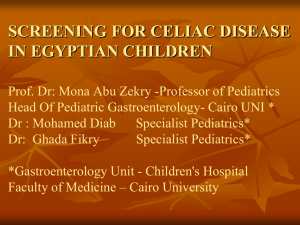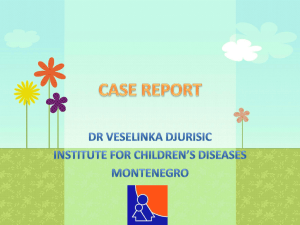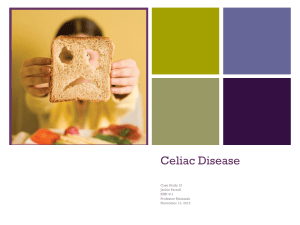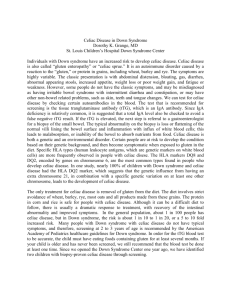Template for preparing articles
advertisement
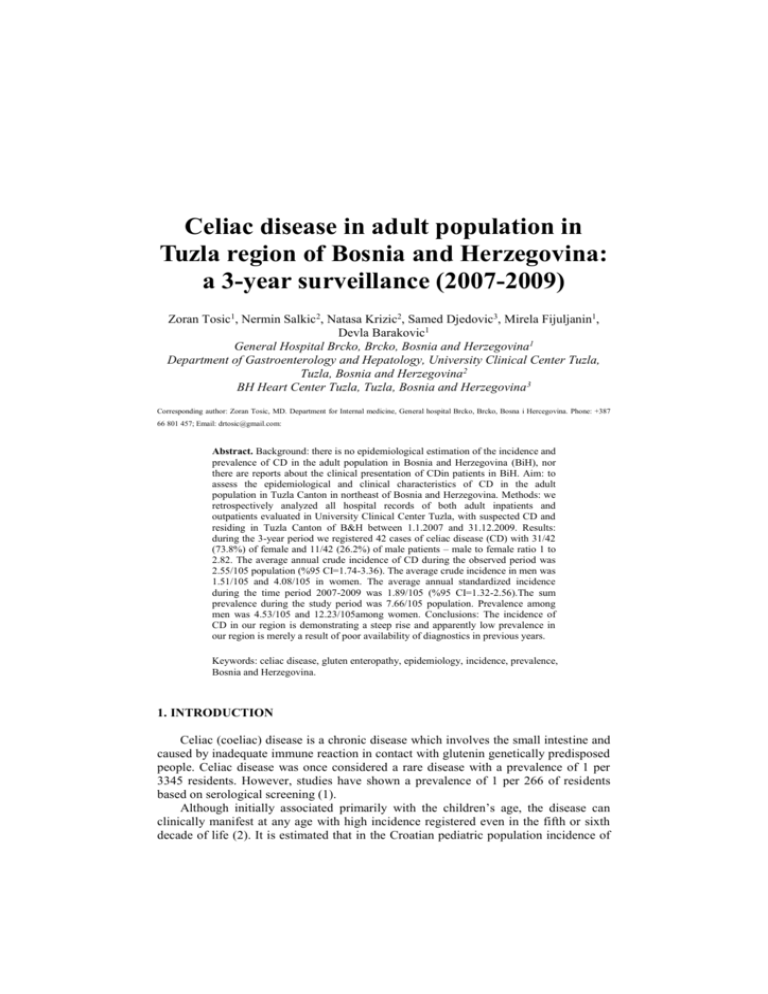
Celiac disease in adult population in Tuzla region of Bosnia and Herzegovina: a 3-year surveillance (2007-2009) Zoran Tosic1, Nermin Salkic2, Natasa Krizic2, Samed Djedovic3, Mirela Fijuljanin1, Devla Barakovic1 General Hospital Brcko, Brcko, Bosnia and Herzegovina1 Department of Gastroenterology and Hepatology, University Clinical Center Tuzla, Tuzla, Bosnia and Herzegovina2 BH Heart Center Tuzla, Tuzla, Bosnia and Herzegovina 3 Corresponding author: Zoran Tosic, MD. Department for Internal medicine, General hospital Brcko, Brcko, Bosna i Hercegovina. Phone: +387 66 801 457; Email: drtosic@gmail.com: Abstract. Background: there is no epidemiological estimation of the incidence and prevalence of CD in the adult population in Bosnia and Herzegovina (BiH), nor there are reports about the clinical presentation of CDin patients in BiH. Aim: to assess the epidemiological and clinical characteristics of CD in the adult population in Tuzla Canton in northeast of Bosnia and Herzegovina. Methods: we retrospectively analyzed all hospital records of both adult inpatients and outpatients evaluated in University Clinical Center Tuzla, with suspected CD and residing in Tuzla Canton of B&H between 1.1.2007 and 31.12.2009. Results: during the 3-year period we registered 42 cases of celiac disease (CD) with 31/42 (73.8%) of female and 11/42 (26.2%) of male patients – male to female ratio 1 to 2.82. The average annual crude incidence of CD during the observed period was 2.55/105 population (%95 CI=1.74-3.36). The average crude incidence in men was 1.51/105 and 4.08/105 in women. The average annual standardized incidence during the time period 2007-2009 was 1.89/105 (%95 CI=1.32-2.56).The sum prevalence during the study period was 7.66/105 population. Prevalence among men was 4.53/105 and 12.23/105among women. Conclusions: The incidence of CD in our region is demonstrating a steep rise and apparently low prevalence in our region is merely a result of poor availability of diagnostics in previous years. Keywords: celiac disease, gluten enteropathy, epidemiology, incidence, prevalence, Bosnia and Herzegovina. 1. INTRODUCTION Celiac (coeliac) disease is a chronic disease which involves the small intestine and caused by inadequate immune reaction in contact with glutenin genetically predisposed people. Celiac disease was once considered a rare disease with a prevalence of 1 per 3345 residents. However, studies have shown a prevalence of 1 per 266 of residents based on serological screening (1). Although initially associated primarily with the children’s age, the disease can clinically manifest at any age with high incidence registered even in the fifth or sixth decade of life (2). It is estimated that in the Croatian pediatric population incidence of celiac disease is 1.9 : 1000 births, while in adult population there are nearly 40000 unidentified patients with celiac disease (3). It is believed that the ratio of diagnosed and undiagnosed cases of the disease in Europe is 1 to 5-13 residents, while there is a reliable report that this ratio may be much higher in USA (1:53) (4, 5). The true prevalence of celiac disease is difficult to grasp, because many patients have atypical symptoms or no symptoms at all. According to available data, there is no epidemiological estimation of the incidence and prevalence of celiac disease in the adult population in Bosnia and Herzegovina(B&H), nor there are reports about the clinical presentation of celiac disease in patients in B&H. Therefore, we aimed to assess the epidemiological and clinical characteristics of celiac disease in the adult population in Tuzla Canton in northeast of Bosnia and Herzegovina. 2. PATIENTS AND METHODS We retrospectively analyzed all hospital records of both inpatients and outpatients evaluated in Department of Gastroenterology and Hepatology, Endoscopy Unit and Department of Pathology in University Clinical Center Tuzla, with suspected celiac disease and residing in Tuzla Canton of B&H between 1.1.2007 and 31.12.2009. We included adult patients with age over 18 years. We excluded all patients that did not reside in Tuzla Canton. After that, we selected all patients with histological and serological confirmation of celiac disease. We also recorded age, gender, date of initial diagnosis, clinical representation, body mass index, presence of anemia and other relevant clinical symptoms. We excluded patients with incomplete records. 3. STATISTICAL ANALYSIS Statistical analysis was performed using SPSS 20.0 (SPSS, Chicago, IL, USA). Descriptive statistics has been used for determination of baseline characteristics. The year of diagnosis was used to date incidence. Calculations of incidence have been performed based on the appropriate (December 31st, 2009) population estimates in our region obtained from the Federal Office of Statistics, Federation of Bosnia and Herzegovina, Sarajevo. Ninety five per cent confidence intervals (95% CI) of incidence rates were estimated assuming a Poisson distribution of cases. Crude annual incidence rates were calculated based on the number of patients diagnosed and the number of inhabitants for both sexes while average incidence rate during observed period was calculated based on number of study years. Age standardized incidence rates were calculated using European standard population weights (4, 7, 11, 14, 22) for each of our age group (6). Prevalence estimate during observed period was estimated based on the total number of cases detected and the number of inhabitants according to latest population estimates. Statistical level of 95% (p<0.05) was considered as significant for all performed tests. 4. RESULTS During the 3-year period we registered 42 cases of celiac disease (CD) with 31/42 (73.8%) of female and 11/42 (26.2%) of male patients – male to female ratio 1 to 2.82. The median age in all patients with celiac disease was 36 years (interquartile range 29 to 42 years) with a range spanning from 19 to 58 years. There was no significant age difference (t=0.10; df=40; p=0.92) between men (36±12 years) and women (36±10 years). Clinical characteristics of celiac disease at the moment of detection are presented in Table 1. Table 1. Clinical characteristics of celiac disease in patients detected in Tuzla Canton from year 2007 to 2009 Clinical characteristics N Percentage Anemia 25/42 59.5% Body Mass Index below normal 27/42 64.3% AGA antibodies present 39/42 92.9% EMA antibodies present 41/42 97.6% Comorbidities (hypothyreosis) 6/42 14.3% Diarrhoea 35/42 83.3% Abdominal cramps 4/42 9.6% Weight loss 3/42 7.1% Dominant symptom The average annual crude incidence of celiac disease during the observed period was 2.55/105 population (%95 CI=1.74-3.36). The average crude incidence in men was 1.51/105 and 4.08/105 in women. After we performed standardization according to standard European population, the average annual standardized incidence during the time period 2007-2009 was 1.89/105 (%95 CI=1.32-2.56). The sum prevalence during the study period calculated for population numbers on 31.12.2009, was 7.66/105 population. Prevalence among men was 4.53/105 and 12.23/105 among women. The annual incidence for men and women and complete sample is depicted in Figure 1. As demonstrated incidence rates are demonstrating steady increase. Figure 1. Annual incidence of celiac disease in Tuzla region of Bosnia and Herzegovina during the period 2007-2009 in both gender and complete sample. The graphic display of incidence according to gender and age is presented in Figure 2. The largest incidence was found in women age 26-35, while peak incidence in men was in older age group of 36-45. Figure 2. Incidence of celiac disease according to age at the time of diagnosis and gender of the patient. 5. DISCUSSION Until the late 1970s global prevalence of celiac disease was greatly underestimated with reported rates of 0.03% in general population (7). Nowadays, estimated prevalence in general population in Europe and USA is around 1%, ranging from 0.5 to 1.26% (8). Approximately 3 million people in Europe and another 3 million people in the United States are estimated to be affected by celiac disease with higher prevalence in European countries with temperate climates. Although the actual occurrence of celiac disease has been underestimated for years, the prevalence of the disease is increasing, mainly due to the advances in diagnostic methods and improvements in screening. This is especially valid for developing countries such as Bosnia and Herzegovina. Unfortunately, as with many other conditions, the data about epidemiology of celiac disease in Bosnia and Herzegovina is non-existing and this is valid for both pediatric and adult population. The improvements of diagnostic tools along with the improved awareness especially in the adult population are producing increasing number of patients – number that we don’t know about. Therefore it was our intention to make as accurate assessment of the epidemiology of celiac disease in adult population in a well-defined region of Bosnia and Herzegovina. Of course, it is not possible to compare our prevalence rates since they are calculated only for a three-year period of the present study, however the exceptionally well executed study from USA estimated that there are 53 undiagnosed patients for each celiac disease patient (5). And this is the case for a country with highly developed health system. As visible from Figure 1, the incidence rates in our region in a 3-year period are in a accelerated rise, as a result of a better ascertainment and availability of diagnostics in our region. We estimate that the prevalence of celiac disease in our region is comparable with surrounding countries. As with many other autoimmune diseases, celiac disease is more common in women with a female to male ratio of between 2:1 and 3:1 (9, 10). According to our study, there is also a comparable predominance of female patients with similar ratio. There is a speculation that some genetic loci are gender-influenced and immunoregulation is subject to hormones, which might explain gender differences (11). Interestingly, patients over 60 who are diagnosed with celiac disease are more commonly male (12). Celiac disease can be diagnosed at any age with a peak at early childhood and at the fourth and fifth decade of life. One must bear in mind that our study observed only adult population and we detected peak incidence in age group 36 to 45 years. However it is important to note that peak incidence for women in our study spans toward the age group of 26 to 35 years. The diagnosis of celiac disease in advanced age is probably a result of a diagnostic delay, rather than a result of possible late onset of the disease. Nevertheless there are contradictory reports with some studies in favour of diagnostic delay and other in favor of late development (13, 14, 15). Celiac disease along with classical symptoms of diarrhea, steatorrhoea and weight loss may encompass a broad spectrum of other clinical manifestations especially in adult population. These symptoms are associated with a large variety of changes in the intestinal mucosa (16, 17). According to a survey in the pediatric population in the area of Punjabin northern India, malnutrition was clinically apparent in 83% children (18) and other study reported prevalence of 65% of patients with different degrees of malnutrition. Our patients were also malnourished in around 2/3 of cases according to the BMI value. 6. CONLUSION Numerous studies have shown a high degree of interest in the frequency of symptoms and signs of celiac disease, given the pathophysiological disorder that ultimately leads to a decrease in intestinal absorption. Diarrhoea as a dominant symptom is established in numerous studies, some of which reported diarrhea as the first symptom in around 90% of patients (19). Nonspecific abdominal pain still persist in about half of patients and weight loss was recorded in least one-third of patients (20). Apparently, our patients do fit into described pattern of clinical representation with most of them presenting with diarrhea as a first clinical symptom, with anaemia and weight loss present in around 2/3 of patients. There are several limitations of our study that need to be addressed. This is a hospital-based series and there is a possible limitation of referral bias. Also, it is based on patient records from a single hospital. Yet, our hospital is the only centre in our region with the full diagnostic capability for diagnosing of celiac disease so almost all patients eventually end up in our centre. Nevertheless, we allow for possibility that small number of patients remains undetected. At the end, as with many other countries, we feel that we in Bosnia and Herzegovina are only uncovering the top of the iceberg when dealing with celiac disease. The incidence in our region is demonstrating a steep rise and apparently low prevalence in our region is merely a result of poor availability of diagnostic in previous years. Celiac disease in adult population is more frequent than previously imagined and should be taken into account in each patient with possible signs of intestinal disease. REFERENCES 1. 2. 3. 4. 5. 6. 7. 8. 9. 10. 11. 12. 13. 14. 15. 16. 17. 18. 19. 20. Fasano A, Catassi C. Current approaches to diagnosis and treatment of celiac disease: an evolving spectrum. Gastroenterology. 2001; 120: 636-651. Zipser RD, Patel S, Yahya KZ, et al. Presentations of adult celiac disease in a nationwide patient support group. Dig Dis Sci. 2003; 48: 761-764. Matek Z, Jungvirth-Hegedus M, Kolacek S. Epidemiology of coeliac disease in children in one Croatian county: the cumulative incidence over ten-year period and the way of clinical presentation (Part I). Coll Antropol. 1999;23: 621-628. Farrell RJ, Kelly CP. Celiac sprue. N Engl J Med. 2002; 346: 180-188. Fasano A, Berti I, Gerarduzzi T, et al. Prevalence of celiac disease in at-risk and not-at-risk groups in the United States: a large multicenter study. Arch Intern Med. 2003; 163: 286-292. Doll R, Cook P. Summarizing indices for comparison of cancer incidence data. Int J Cancer. 1967; 2: 269-279. Lohi S, Mustalahti K, Kaukinen K, et al. Increasing prevalence of coeliac disease over time. Aliment Pharmacol Ther. 2007; 26: 1217-1225. Dube C, Rostom A, Sy R, et al. The prevalence of celiac disease in average-risk and at-risk Western European populations: a systematic review. Gastroenterology. 2005; 128: S57-s67. Jacobson DL, Gange SJ, Rose NR, et al. Epidemiology and estimated population burden of selected autoimmune diseases in the United States. Clin Immunol Immunopathol. 1997; 84: 223-443. Peters U, Askling J, Gridley G, et al. Causes of death in patients with celiac disease in a populationbased Swedish cohort. Arch Intern Med. 2003; 163: 1566-1572. Tack GJ, Verbeek WH, Schreurs MW, et al. The spectrum of celiac disease: epidemiology, clinical aspects and treatment. Nat Rev Gastroenterol Hepatol. 2010; 7: 204-213. Green PHR, Stavropoulos SN, Panagi SG, et al. Characteristics of adult celiac disease in the USA: results of a national survey. Am J Gastroenterol. 2001; 96: 126-131. Ludvigsson JF, Brandt L, Montgomery SM. Symptoms and signs in individuals with serology positive for celiac disease but normal mucosa. BMC Gastroenterol. 2009; 9: 57. Lurie Y, Landau DA, Pfeffer J, et al. Celiac disease diagnosed in the elderly. J Clin Gastroenterol. 2008; 42: 59-61. Vilppula A, Kaukinen K, Luostarinen L, et al. Increasing prevalence and high incidence of celiac disease in elderly people: a population-based study. BMC Gastroenterol. 2009; 9: 49. Kaukinen K, Maki M, Partanen J, et al. Celiac disease without villous atrophy: revision of criteria called for. Dig Dis Sci. 2001; 46: 879-887. Wahab PJ, Crusius JB, Meijer JW, et al. Gluten challenge in borderline gluten-sensitive enteropathy. Am J Gastroenterol. 2001; 96: 1464-1469. Pooni PA, Chhina RS, Jaina BK, et al. Clinical and anthropometric profile of children with celiac disease in Punjab (North India). J Trop Pediatr. 2006; 52: 30-33. Kamilova AT, Aripov AN. [Clinico-laboratory parallels during celiac disease in children]. Klin Lab Diagn. 2000: 39-42. Collin P, Reunala T, Pukkala E, et al. Coeliac disease - associated disorders and survival. Gut. 1994; 35: 1215-1218.

